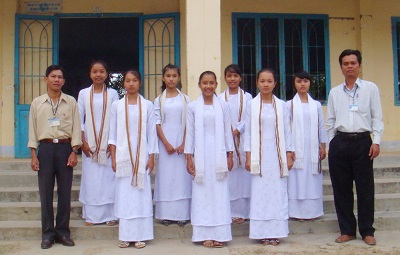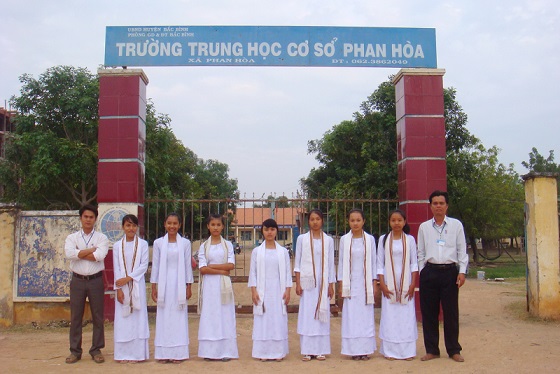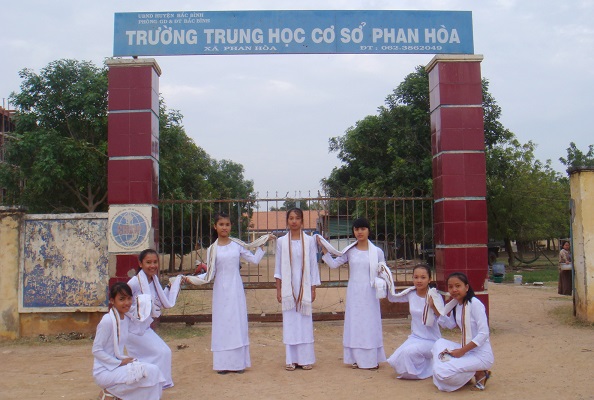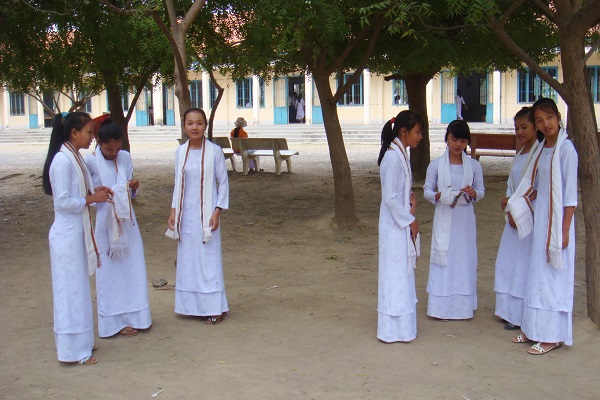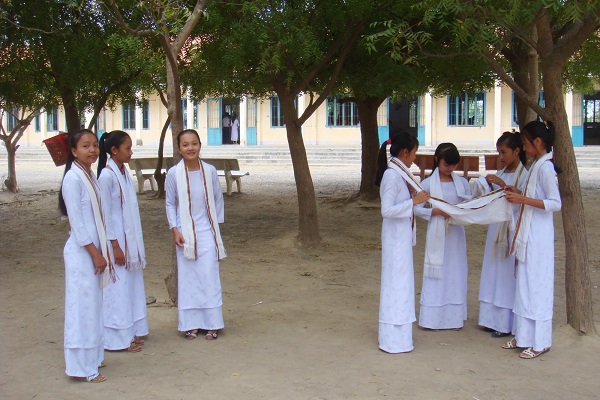Van Ngoc Sang, Mohamad Bin Bilal Ali, Hamdan Bin Said. Information Technology and Indigenous Language Preservation, a Case Study in the Malayu Cham Language in Viet Nam. Proceeding of International Conference on “The 10-Year Implementation of the UNESCO Convention for the Safeguarding of Intangible Cultural Heritage: Experiences, Lessons and Future Directions”. Viet Nam, June 22-23, 2013.
Summary: Every own language of ethnic groups is formed and developed for a long time in historical process. Language is a unique symbol of the nation, it is also cultural identity and cultural heritage, and its purpose transfers the experience and knowledge from old generations to the next generation. Indigenous languages conservation issues in the world have been becoming knock the alarm when there have about 2,500 languages in approximate 6,900 languages which are being used around in the world, that are in endangered of disappearing (UNESCO, 2010). In the world, India is the top of the list of countries where have many endangered languages when most of 196 endangered languages are counted in this country. In Vietnam, there have 54 different ethnic languages which are formed and developed during ups and downs of historical process. Some of them are well developed language and become popular, such as Vietnamese language. The others have been used in the community to become minority languages.
Cham people are ethnic groups of the Champa kingdom was established in the second century in central Vietnam, a country influenced by Hindu civilization, but Cham people have a language and their own script. Cham script has a separate character system, derived from the Devanagari script of India (Lafont, 2011), first appeared on the inscriptions Vo Canh stone stele (Nha Trang, Vietnam) in the second century (Filliozat, 1969)
Cham language is the indigenous language in Vietnam but now it is one of the language minorities. However, in terms of history, the Cham writing appeared first in stone stele such as Dong Yen Chau, Tra Kieu in the fourth century. These affirmed that the Cham people used it to express ideas and communicate daily for a long time. Due to many reasons and influenced by history, Cham population are now just over 150 thousand people in Vietnam, therefore the Cham language is facing endangered and they are at risk of deformation for various reasons.
This paper aims to introduce some specific features of information technology in Cham language heritage conservation in Vietnam. Research for Cham writing conservation through the development of Website design for hosting and promotion Champa royal documents; online electronic dictionaries, fonts and Cham keyboards.... Storing voice of Cham language through over audio files; teaching and learning Cham language is through multimedia tools...
Using information technology to preserve heritage language has been used in many countries and brings significant efficiencies. The multimedia features of the storage and transmission of information fast, wide and accurately. Using information technologies to preserve the Cham language heritage is not only theoretically significant but also has practical significance conservation of heritage languages of ethnic groups in the development process.
1. Applications of information technology to preserve indigenous languages in the world and in Vietnam
Using information technology to preserve the endangered language is not new in the world today when digital technology has developed powerfully. Its effective has enormous features and varieties of storage and dissemination of information. Information technology has significantly contributed in the indigenous language education, restoring and preserving of ancient writing system is a very obvious fact in many countries (Grenoble & Whaley, 2006). During the years of the '70s, Apple was the first company to launch the modern computer, and followed the line of the new computer IBM also launched in the next decade has increased the number of computer users to access and exchange information. Until the early '90s, we witnessed a series of digital technology products appeared such as Video CD, CDROM, digital video, 3D systems, multi-function memory card, high speed internet, ... Ever since then, the internet has expanded rapidly and allow people to search the world's information via the website, therefore, they can download documents, audio or video files stored easily. Regarding communication, people also exchange information system which is supported by electronic mail, blog, chat, webcam, (Murdock, 2004). And since then, many indigenous communities access quickly new information technologies as an effective means to restore and preserve their own language, such as video, multimedia (Penfield, Cash, Galla, Williams, & ShadowWalker, 2006).
Currently, in most countries around the world, information technology systems has become a powerful tool for supporting the work of teaching, restore and preserve indigenous languages, namely through the field 1) preservation of the Indigenous language; 2) material development and dissemination; 3) multiple modes of communication; and 4) achieving relevance, significance and purpose can be applied to other Indigenous languages as well (Warschauer, 1998).
This is especially significant useful when indigenous languages conservation issues in the world knocking the alarm about 2,500 languages in some 6,900 languages are in use around the world at risk of disappearing (UNESCO, 2010). Facing to this fact, in June 2012, Google has launched a website with the address endangeredlanguages.com, to contribute to preserving the languages which are on facing of extinction. The name of project is "Project rescue endangered languages " in the Google search is hoping that as applying the most advanced achievements of technology to encourage of the individual in-depth understanding, and collaboration with the provision of an integrated database, that will lead to the result of preservation and maintain the indigenous language.
2. Rationale and practical preservation of Cham language
2.1 Summary of the formation and development of Cham language
Cham language is one of the languages in family of multy-island "Austronesian". Therefore Cham language is close relationship with Malay. Compared to the Malay, which has been found in the 7th century, while Cham letters has also appeared on the first stone stele, namely of Dong Yen Chau (Tra Kieu) in the 4th century (Al-Ahmadi, 1988; Coedes, 1939). This evidence allowed us to know that in the fourth century, Champa tribes was living in the Tra Kieu and used Cham language at that time to express their ideas.
In history, people always have an own language, however, they also borrow others language to disseminate of thoughts and exchange information with others. For example, some ethnic groups in Southeast Asia, including Cambodia, Indonesia, Laos, Thailand, etc., in addition to their native language; they also borrow foreign language as a means to exchange information. Therefore, in ancient Champa was not inevitably except this rule. So that, in addition to language Cham kingdom was also used in Sanskrit legacy systems to spread their ideas. Therefore, people often arrange Champa in the case of bilingual nation from the fourth century to the fifteenth century, it means that Champa used for both of Sanskrit and Cham language.
2.2 The necessarily of preservation of the Cham language
According to language experts the Cham language is currently on the way to be endangered by the following reasons:
- The teaching and learning Cham language have only done at the primary in schools, and also inconsistent potential conflicts.
Since 1978, BBSSCC made a new kind of the Cham language based on modifying the traditional Cham Thrah character, in order to teaching in primary school. But teaching and learning the Cham language also encountered many difficulties such as lack of teachers, Learning in very little amount of time. Especially, curriculum and textbooks are not agreement of different groups, such as monastic order, elders, intellectuals and community with BBSSCC group. (Karim, 2006; Liem, 2006; Sakaya, 2006). Hence when finished primary school, Cham students read-only BBSSCC documents, they cannot read Cham material by fathers leaving as literature or texts Akhar Thrah for them who are using in Cham villages today (Han, 2006).
- Lack of agreement between traditional Cham Thrah and modified Cham Thrah character after 1978
There have many scientific conferences be held to solve this issue during the period of time when the BBSSCC established. Especially, the international conference on "Language history and Cham writing" was held in Kuala Lumpur in the year 2006, showed that the modified Cham Thrah after 1978 did not strictly follow rules of traditional Cham script but there was an arbitrary modification and its result leads to greater disturbance in language structure which was inherently stable since the seventeenth century. Improving the Cham of writing from BBSSCC that made to deviate away of conservation's goals of Cham language (Dominique, 2006; Han, 2006). Instead of applying of the traditional Cham language in teaching curriculum, BBSSCC made the new Cham language by innovative re-add or cut off some of characters. This has caused many conflicts in conservation of Cham language.
- There are a lot of documents stored in Cham dignitaries, elders, monks, some individual or organizations.
In current reality, there are a large number of documents written in traditional Cham Thrah which are restored in every Cham village, library in Vietnam, especially in the French. If conservation of traditional Cham is not done well, the younger generation will neither read the Cham nor understand the value of the stored material system. This will cause unintended harm to the education and cultural preservation and conservation the Cham language in particular.
For these reasons, the preservation of traditional Cham Thrah languages is urgently needed and should be done synchronously with the active participation of many agencies, professionals and Cham community.
2.3 A number of inadequacies in Cham language modified
According to Dr. Phu Van Han and other experts at workshop in Kuala Lumpur in 2006, the Cham language teaching is the inconsistency in the current period because the Cham Thrah character in Cham writing has stabilized before the 17th century and it has disordered when BBSSCC agency bring these books to teach for primary school where has the Cham student people. Here is some causes disturbance arising out of this:
- Creating the Cham word has "paoh gak" (ie consonant <g> at the end of the word) to solve for the short vowel or long vowel, because in Cham language system no have "paok gak" character,
- Omitted the "dar tha" in "craoh aw" notation,
- Use symbols "hua baluw" with notation "tha dar, dar dua" is a diphthong (ai),
- Use "takai kik tut takai mâk" in freely,
- Use "baluw" in arbitrarily,
- Use the word "pak praong" and "pak asit" unscientific.
2.4. Surveys of choosing the kind of Cham writing for conservation
With the exist of two types of Cham writing, Cham traditional and the Cham modify of BBSSCC, we have conducted a survey on the social which kind of Cham writing need to preserve. With more than 250 surveys for 3 groups: 1) elders, and religious leaders 2) intellectuals and students 3) people (in the village). The results shown in Figure 1:
Figure 1. Chart of choosing Cham language to use
The chart shows that the number of respondents in all three groups supports the use of traditional Cham whereas only a few accounts for 1.16% supporters for the use of the ham modify of BBSSCC. Especially, there is 100% concern the elders and religious leaders supported the traditional Cham Thrah, they do not know modified Cham Thrah of BBSSCC. During their survey, they truly requested that the Cham people should use Cham Thrah tradition.
-Refer of results from online survey
Recently, the website" gulpataom.com" practice the online survey which conducted on selected Cham Thrah tradition or Cham Thrah modify of BBSSCC, this aimed to find common ground community in preserving Cham. As of 05.20.2013 the survey results showed that as in Figure 2: As there were a large number of people (as 145 people), accounting for 92.95% supported the use of the word traditional Akhar Thrah Cham and only 11 people accounted 7.05% selected the Cham Thrah modify of BBSSCC. This is a reference to results in the selection of scripts to use and conservation.
Figure 2. Result of choosing Cham language to use by online
(Source gulpataom.wordpress.com)
- Opinions of language experts
In workshop on history of Cham language (Bien_ban, 2006), the conclusion of expert’s opinions following comments:
- Akhar Thrah handwriting of the Cham people have longstanding, transmitted from generation to generation, is the spiritual heritage of the Cham people and cultural heritage of humanity, which has been recognized in the Charter of UNESCO. Therefore, any modifications of Akhar Thrah Cham must have right reasons and the agreement of all the Cham people that they are representing the religious order, elders, intellectuals, researchers who are using Akhar Thrah now in everyday life.
- Like all literate people in the world, the Cham has only one language and a common script: It is Akhar Thrah. The voice of the Cham people can turn depending on the region and time, but the Cham script is always stable.
- In the course of history, the Cham writing people as well as anyone else in the world of writing inevitably rule improvements. However, this improvement must always be associated with language rules and based on rigorous scientific basis.
- The owner of Akhar Thrah is all that Cham who are representative of the religious order, elders, intellectuals, researchers are using Akhar Thrah.
- The Akhar Thrah traditional Cham circulation from the 17th century until today is popular; it is not the old hand writing general, and has very stable laws and stable system. Akhar Thrah Cham do not have “paoh Gak”, “craoh aw” must always be "dar tha" and never "baluw" on "dar-dar tha dua".
- As with any language in the world, Akhar Thrah Cham rules and any separate rules that people must learn to accept. Since this is a sacred cultural heritage of a people who should not have any reason to modify.
Through exploration of the survey results from different channels as described above, we decided to select the type of text in traditional Akhar Thrah Cham in our technology products for conservation and dissemination to their community.
3. A number of information technology products to support conservation Cham language
In recent years, information technology has supported for conservation of Cham language such as Cham TV, Cham radio, cassette tape, CD, DVD, the websites introduced of the Royal Cham document, Quran, history, literature, customs...
Today, with the advancement of science and technology, new technology products are introduced below that provide more features and benefits as well as convenience for conservation, research and learning Cham language. The preservation of cultural heritage in general and indigenous language in particular has been popular; the strategies of Cham conservation can be developed as model 3.
Figure 3. Cham script heritage preservation model
In short, applying of information technology in preserve indigenous languages is a modern approach and brings enormous benefit for communities.
3.1 Building an electronic dictionary Viet - Cham; Cham - Viet
In order to preserve the ethnic minority’s languages, electronic dictionary is one of the products which support for searching and translation efficiently.
During last time, we have built an electronic dictionary Viet - Jrai (ministerial-level project was accepted in 2008) (Sang, 2008), building an electronic dictionary Viet - Mnong; Mnong - Viet (Science project acceptance Dak Nong province in 2009) (Sang, 2009), building an electronic dictionary Viet - Stieng; Stieng - Viet (Science project acceptance Binh Phuoc province in 2012) (Sang, 2012);
However, there no any electronic dictionary software that supports for research related to Cham language. Currently, we are continuing to build an electronic dictionary Viet - Cham Cham - Viet with the structure as Figure 4 and basic features asshown in Figure 5.
Figure 4. Diagram of the structure of Viet Cham dictionary
Figure 5. Interface of electronic dictionary Viet – Cham; Cham - Viet
3.2. Building dictionary Malay - Cham - Viet
Since many scientific studies have shown that Malay and Cham language vocabulary have the same originality (Majid & Sang, 2013). A large number of original Sanskrit vocabulary and Arab language that both Malay and Cham people often use that have been introduced is very clear evidence to explain the origin Cham. Thus preserving Cham language is not just for the Cham people but also in the meaning of international integration.Currently, we are conducting statistic and surveys he number of Cham and Malay words which are also derived from the power to the building dictionary in both of paper and electronic. Technology products will contribute actively in conservation as well as expand the number of participants to learn research and service learning.
3.3 Improved Cham font
Since the development of information technology, support for text editor on the Cham language in computer, many units and individuals have created many kinds of research Cham fonts for Windows and Macintosh environments such as akhar . ttf, akhar praung.ttf, akhar rik.ttf, akhar sanscrit.ttf, champa.ttf, camtanran.ttf, bingu di tanran.ttf
In the process of research and analysis above shows that all of the font encoding to Unicode standard assign character (code point), that represents a character or mark the Cham language is quite different.
According to the survey by the fact that the process used to create font camtanran.ttf by EFEO for Macintosh computers is beautiful and popular. However, when using in the Windows system this font typing is no longer relevant. bingu di tanran.ttf font is developed from rebuilding camtanran.ttf for Windows platforms and redesigned the characters on the keyboard. That is very easy to remember and accurate. However, in the period of using this font is facing some obstacles and not stable. Therefore, we continue to improve from camtanran.ttf font based on a set of bingu di tanran.ttf for Windows platforms and named it cam_thrah.ttf (Figure 6), this font is now used fairly stable and suitable for traditional typing of Thrah Cham characters.
Figure 6. Table selection code point for each character of the cam_thrah.ttf font
According to the surveyed of 150 audience for the intellectuals and Cham students, who have more opportunities to use computers and the media work, research and study, we collected outcome of which is Cham font kind is used utility and facilitate for writing the Cham language in computer. The result as shown in Figure 7:
Hình 7. Result survey of some Cham font in using
The result on the graph in Figure 7 shows that there was 50.6% of the survey participants preferred to use Cham Thrah font, while 35.4% have used Bingu di Tanran font, the remaining 14% use EFEO PC font. Discuss to us about the effectiveness of the font features Cham Thrah, most of users think that this font using is more convenient than the previous fonts.
3.4. Video clip Cham language teaching
The teaching and learning of Cham language in schools are still significant difficult. To further support the teaching and learning of Cham language for children, as well as creating conditions for a number of people who do not have the condition to go to class and they must self-study Cham language. A video clip of self-study products in teaching Cham language is considered effective and handy. With the video clip system often structured topic, each topic includes several articles, with photos and audio support, that will help people to easy to learn, easy to remember and easy to apply. Trainees can enroll online or may download up to computer learning and regular refresher without pay a lot of time and money. Currently, the economic life of the Cham very difficult so this is a practical solution to support the teaching and learning as well as language preservation Cham.
3.5. Storing Champa royal documents in digital technology
Champa royal documents were found in the Lavang village of ethnic Kaho (group) in the area of Dong Nai, Lam Dong by Mr. P. Villaume in 1902 and it was introduced in the initial essay of E. M. Durand titled: "Les archives des Rois derniers chams" (BEFEO VII, 1907, p. 353 355). Currently, France and the South East Institute of the Malaya University in Malaysia have collaborated programs to conserve this precious material via DVD and online systems.
These documents are stored in the ASIATIQUE Société de Paris library. Among that, a total of 5227 pages, including Cham written in 4402 and 825 pages written in Chinese, from 1702 to 1883, under the ChinhHoa King (1680 - 1705), Bao Thai (1720-1729), Vinh Khanh (1729-1732), Long Duc (1732-1735), Huu Vinh (1735-1740), Canh Hung (1740-1786), Thai Germany (1778-1793) , Gia Long (1802-1820), Tu Duc (1874-1883). This is the official records of the Champa dynasty. There were the kings stamped and signed of the parties, focused topics ranging from administrative documents, tax documents, to purchase land for litigation documents, etc. (Dharma, 2012).
Currently works of copy and put them into files saving in computer for storage, Latin transcriptions and summaries of the contents of each file has been made completed. Digital Technology powerfully support actively in restoring of this document, while the traditional methods can hardly keep records in long time since these document were obsolete and in danger of decay.
Champa royal document, number of 285, p. 1b. Text of taxes payable to the State stamped in Chinese. Last in the first of honeymoon week, in December, Dog year, and the Monday of Cham calendar, probably in 1743 (source EFEO).
4. Conclusions and recommendations
Application of information technology is necessary and effective to preserve and develop the indigenous language in general and in case study of the Cham language following the policy of the Vietnamese government. Today, the rapid development of information technology has brought many benefits as well as practical efficiency for the data storage, access, search, as well as create new text... This is not just positive to serve the interests of preservation and development of language, but also support for the research and academic teaching staff, students and foreign students.
Especially for ancestral Cham material has not still been preserved, and decoding fully for studying. The new technology software’s are introduced in this paper that are essential for conservation and overweight the previously traditional methods hard to achieve.
However, in order for the application of information technology in the preservation and development of Cham language effectively, we should have the interest and investment from local authorities. Moreover, there have a need of power efforts from information technology professionals and experts in the investment to development of new technology as well as transfer it’s useful to practical application. It is necessary to encourage and facilitate for more and more Cham people (dignitaries, elders, priests, intellectuals, students and citizen) use these new technologies for preservation indigenous language in Vietnam.
Referrence
Al-Ahmadi, A. R. (1988). Campa dengan alam Melayu. Alam Melayu: Sejarah dan Kebudayaan Campa, Kementerian Kebudayaan dan Pelancongan &, EFEO, Kuala Lumpur., p.73.
Bien_ban. (2006). Biên bản hội thảo về lịch sử ngôn ngữ và chữ viết Chăm. Kỷ yếu hội thảo : Lịch sử ngôn ngữ chữ viết Chăm, Kuala Lumpur, EFEO & Tokyo University of Foreign Studies, Kuala Lumpur, 2007 (CD-Rom)
Coedes, G. (1939). La plus ancienne inscription en langue chame. Eastern and Indian Studies in Honour of F.W. Thomas. New Indian Antiquary Extra Series I., p. 46-49.
Dharma, P. (2012). Giới thiệu tài liệu hoàng gia Champa. Viện Viễn Đông Pháp (EFEO).
Dominique, N. (2006). Chung quanh vấn đề sự chỉnh lý tiếng Chăm sau năm 1978. Kỷ yếu hội thảo : Lịch sử ngôn ngữ chữ viết Chăm, Kuala Lumpur, EFEO & Tokyo University of Foreign Studies, Kuala Lumpur, 2007 (CD-Rom).
Filliozat, J. (1969). L'inscription dite "de Vo canh". in BEFEO LV 1, pp. 107-116.
Grenoble, L. A., & Whaley, L. J. (2006). Saving languages: An introduction to language revitalization. Cambridge, UK: Cambridge University Press.
Han, P. V. (2006). Akhar thrah với việc cải tiến của Ban Biên Soạn sách chữ Chăm. Kỷ yếu hội thảo : Lịch sử ngôn ngữ chữ viết Chăm, Kuala Lumpur, EFEO & Tokyo University of Foreign Studies, Kuala Lumpur, 2007 (CD-Rom).
Karim, A. (2006). Vấn đề chữ viết Chăm ngày nay. Kỷ yếu hội thảo : Lịch sử ngôn ngữ chữ viết Chăm, Kuala Lumpur, EFEO & Tokyo University of Foreign Studies, Kuala Lumpur, 2007 (CD-Rom).
Lafont, P.-B. (2011). Vương Quốc Champa Địa Dư, Dân Cư và Lịch Sử. International Office of Champa, San Jose.
Liem, T. N. (2006). Vấn đề cải biên một số chữ viết Chăm. Kỷ yếu hội thảo : Lịch sử ngôn ngữ chữ viết Chăm, Kuala Lumpur, EFEO & Tokyo University of Foreign Studies, Kuala Lumpur, 2007 (CD-Rom).
Majid, Y. A., & Sang, V. N. (2013). Từ vựng Mã Lai-Chăm có cùng nguồn gốc. Website Champaka.info.
Murdock, E. (2004). History of computers in education. Retrieved on Nov. 19, 2008 at http://www.csulb.edu/~murdock/histofcs.html.
Penfield, S., Cash, P. C., Galla, C. K., Williams, T., & ShadowWalker, D. (2006). Technology-enhanced language revitalization (2nd ed.). Tucson, AZ: University of Arizona.
Sakaya. (2006). Giáo trình dạy chữ Chăm và hậu quả của việc cải biên ngôn ngữ và chữ viết của BBSSCC Ninh Thuận Việt Nam. Kỷ yếu hội thảo : Lịch sử ngôn ngữ chữ viết Chăm, Kuala Lumpur, EFEO & Tokyo University of Foreign Studies, Kuala Lumpur, 2007 (CD-Rom).
Sang, V. n. (2008). Phần mềm từ điển điện tử Jrai-Việt. Trường đại học Tây Nguyên. http://tttt.gialai.gov.vn/index.php?option=com_content&view=article&id=141:-tai-khoa-hc-t-in-in-t-jrai-vit&catid=54:cong-ngh-thong-tin&Itemid=117.
Sang, V. N. (2009). Xây dựng phần mềm từ điển điện tử M’nông - Việt, Việt - M’nông. Trường đại học Tây Nguyên. http://www.baomoi.com/Dak-Nong-Xay-dung-phan-mem-tu-dien-dien-tu-Mnong--Viet-Viet--Mnong/53/3217720.epi.
Sang, V. N. (2012). Xây dựng phần mềm từ điển điện tử Việt – S’tiêng, S’tiêng – Việt. Trường đại học Tây Nguyên. http://www.binhphuoc.gov.vn/3cms/?cmd=130&art=1340589448449&cat=1190772696481.
Warschauer, M. (1998). Technology and Indigenous language revitalization: Analyzing the experience of Hawai‘i. Canadian Modern Language Review, 55(1), 140-61.

